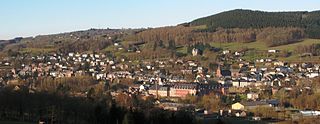
Stavelot is a town and municipality of Wallonia located in the province of Liège, Belgium.

Amandus, commonly called Saint Amand, was a bishop of Tongeren-Maastricht and one of the great Christian missionaries of Flanders. He is venerated as a saint, particularly in France and Belgium.
Acarius, venerated as Saint Acarius, was a monk of Luxeuil Abbey who became Bishop of Doornik and Noyon, which today are located on either side of the Franco-Belgian border.
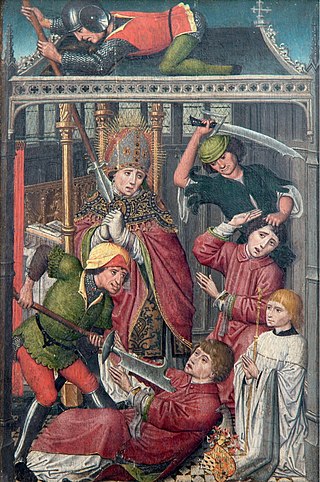
Lambert of Maastricht, commonly referred to as Saint Lambert was the bishop of Maastricht-Liège (Tongeren) from about 670 until his death. Lambert denounced Pepin's liaison with his mistress Alpaida, the mother of Charles Martel. The bishop was murdered during the political turmoil that developed when various families fought for influence as the Merovingian dynasty gave way to the Carolingians. He is considered a martyr for his defence of marriage. His feast day is September 17.

Sep. 9 - Eastern Orthodox liturgical calendar - Sep. 11
Saint Amatus, also called St. Aimé or Aimé of Sion, was a Benedictine monk.

Saint Amatus, (c.560-c.627)) also called Amatus of Grenoble or Saint Ame or Aimee, was a Colombanian monk and hermit. Together with St. Romaric, he founded Remiremont Abbey.

Gregory of Utrecht was born of a noble family at Trier. He became a follower of Saint Boniface, who sent him to study at the Monastery of Saint Michael at Ohrdruf. He then accompanied Boniface on his missionary journeys. In 750, Boniface appointed Gregory abbot of St. Martin's Monastery in Utrecht. St. Martin's became a centre of learning and missionary activity. When, in 754, Eoban left to accompany Boniface on their last missionary trip, Gregory was tasked with administering the diocese of Utrecht, which he did faithfully for the next twenty-three years until his death in 776.
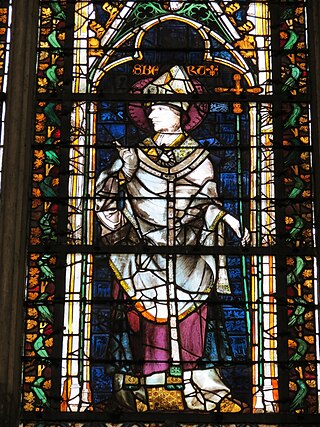
Ansbert, sometimes called Ansbert of Chaussy, was a Frankish monk, abbot and bishop of Rouen, today regarded as a saint in the Catholic Church.

Saint Hadelin, born in Guyenne, was one of the scholarly monks who preached Christianity and started conversion work in what is now Belgium, along with Saint Remaclus.
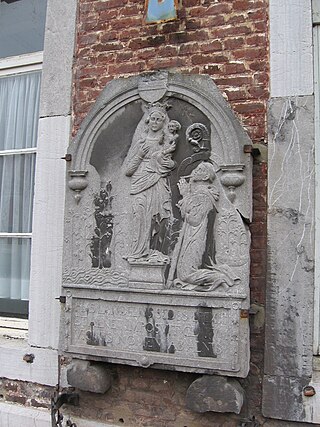
Saint Landelin is a saint in the Eastern Orthodox Church and Roman Catholic Church.

Nicasius, Quirinus, Scubiculus, and Pientia were venerated as martyrs and saints. Their feast day is October 11. Their historicity is uncertain, and "no trustworthy historical reports of [them] exist."

Maurontius of Douai was a nobleman and Benedictine abbot. His parents were Rictrude and Adalbard. He is a Catholic saint, with a feast day on May 5, especially venerated in Douai, France. His sisters Clotsinda, Adalsinda and Eusebia of Douai are also saints.

Saint Poppo was a knight of noble descent who turned to a monastic life after experiencing a spiritual conversion. He became one of the best known abbots of Stavelot and was one of the first recorded Flemish pilgrims to the Holy Land. Liturgically, he is commemorated on the 25th of January.

Theodard of Maastricht was a seventh-century bishop of Maastricht-Liège, in present-day Netherlands. As Theodard was murdered while on his way to protest the plundering of his diocese by Frankish nobles, he is considered a martyr. His feast day is 10 September. Theodard was uncle to his successor Lambert of Maastricht, and therefore brother or brother-in-law to Robert II, Lord Chancellor of France.
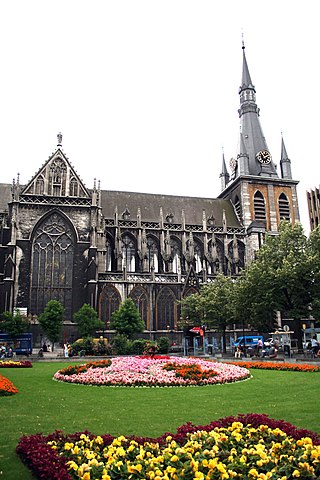
The Diocese of Liège is a Latin Church ecclesiastical territory or diocese of the Catholic Church in Belgium. The diocese was erected in the 4th century and presently covers the same territory as Belgium's Liège Province, but it was historically much larger. Currently, the diocese is a suffragan in the ecclesiastical province of the Archdiocese of Mechelen-Brussels. Its cathedra is found within St Paul's Cathedral in the episcopal see of Liège.
Saint Agilus was a Frankish nobleman who became a Christian missionary in Bavaria and later was abbot of Rebais monastery near Paris, France. He was considered a saint, and his feast day is 30 August.
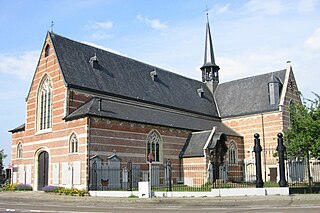
Saint Fredigand of Deurne was an 8th-century Irish missionary in the territory around Antwerp in what is now Belgium. His feast day is 17 July.
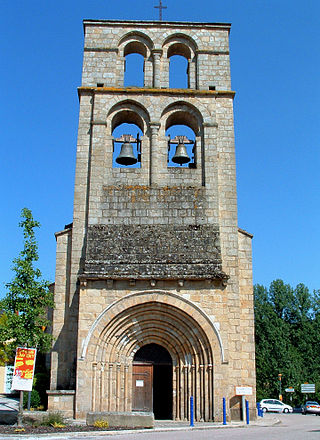
Saint Thillo was a Saxon slave who was converted by Saint Eligius and became a priest at Solignac Abbey. He accompanied Eloi in missionary work, returned to Solignac, and was made abbot. Unable to handle the responsibility, he left the abbey and became a hermit. His feast day is 7 January.


















